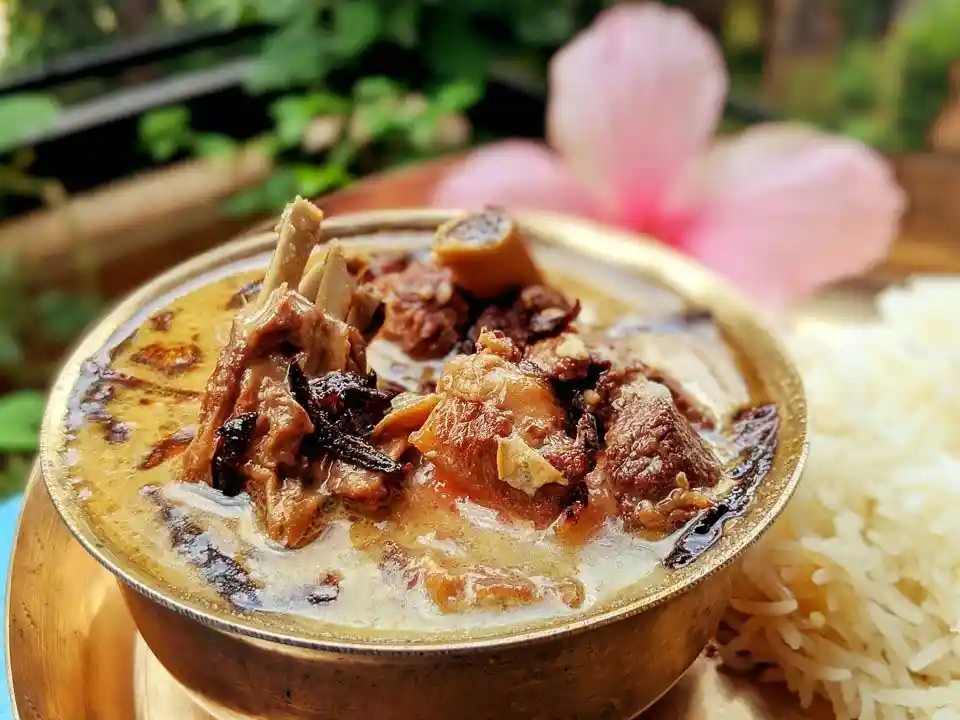Time for a Feast!
Good food always brings a smile to one’s face and warms many hearts. But you know what’s better than good food? A variety of good food. If you find yourself wondering what to eat because your beloved tandoori chicken doesn’t cut it anymore, it’s time to try the 36 dishes of the Kashmiri wazwan.

Aabs Gosht. Image source: Orange wayfarer
Rahim had been watching the men in his family cook for years. He recalled how his grandfather would walk around, inspecting each cut of meat as though he was selecting a gemstone. He remembered that even though his grandfather was well into his 80s, he rose by the crack of dawn and got ready for his duties as the head waza.
Today is a big day. Rahim’s best friend is getting married. But Rahim is a waza and he’d be busy preparing the grand Kashmiri feast. Plus, Rahim could feel the urgency to not make any mistakes because his father was now the head waza. His family has been the guardian of the Kashmiri wazwan. Rahim was 6 years old when he learnt to identify all spices. And he was 10 when he was taught to chop perfect cuts of meat.
The 20-year-old was so confident in his abilities that he’d often break down a whole chunk of meat blindfolded.
As Rahim sliced the lamb for the aab gosh, he remembered his grandfather’s words. Being a waza is a long and slow process and quite like the preparation of the wazwan. By the time the feast is prepared, you’ll have aged beyond recognition.
No wazwan is ever complete without the components that bring out the flavour of the meat. Without desi ghee, cardamom (elaichi), cinnamon (dalchini), dry ginger (shonth), cloves (laung) etc., the food wouldn't taste the same. The spices add aroma and flavour to the dishes.
Preparing 36 dishes with rich gravies is no easy feat. Meat is the core ingredient in the Kashmiri wazwan. All dishes are cooked in traditional copper utensils called the degs, on a hearth made of wood from the old fruit trees.
Traditionally, the food is served in copper plates called tramies (copper plates), and the curried meat is served with fluffy rice. Interestingly, all dishes are brought out in a particular order. However, the fried chicken, kabab, and the Tabak maaz are garnished on top of the rice before being served.
The kabab consists of minced meat, eggs, and a blend of spices. The ingredients are mixed thoroughly and then wrapped around iron skewers. The kababs are charbroiled, as it gives better colour and brings out the juiciness in the meat.
Preparation of the Tabak maaz requires the rib of the mutton. It is cut into small strips and steamed with salt and turmeric. Once the meat softens, the bones are removed, and only the meat is cooked in ghee. The result is a crispy product served with dry spices.
For the wedding feast, some of the dishes prepared by Rahim and the other wazas were kabab, Tabak maaz, aab gosht, rogan josh, nate-yakhni, rista, dum aloo, Marchwagun Korma, Kashmiri Pulao, doon chetin, doudha ras, dum selva, Yakh’n,waza palak, phirni, and goshtaba. The goshtaba is served at the end.>
As Rahim prepared these dishes and watched his father taste every single one of them while adding spices when necessary, he suddenly remembered the legacy of the Kashmiri wazwan and how traditions, when preserved, can add joy to the most blessed occasions.
Watching the guests devour the food and compliment the wazas brought a smile to the faces of the wazas who’d been cooking for more than 6 hours. Rahim was glad that good food made his friend’s wedding even better. He wondered if the Kashmiri wazwan would still be the same when he became the head chef. Although he didn’t know what the future held, he only hoped that the legacy of the Kashmiri wazwan lives on.


